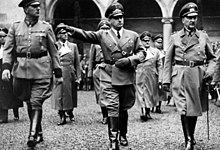Curt Ludwig von Gienanth
Curt Ludwig Freiherr von Gienanth (born December 6, 1876 in Eisenberg , † April 3, 1961 in Heidelberg ) was a German cavalry general as well as military commander and military district commander in the general government during the Second World War .
Life
Gienanth graduated from the Wilhelmsgymnasium in Munich in 1895 and joined the 1st Grand Ducal Hessian Dragoons Regiment (Leib-Dragoons Regiment) No. 24 on March 23, 1896 as a flag junior . He was in command of the Hanover Military Riding Institute until 1897 , and in the same year he was promoted to Second Lieutenant . From mid-November 1901 Gienanth acted as a regimental adjutant and was then commanded from October 1, 1904 for three years for further training at the War Academy . As a lieutenant in April 1909 followed by his commanding of the General Staff , the Gienanth on 20 March 1911 the promotion to captain aggregated was. From April 1, 1911 to September 30, 1913 he was active in the General Staff of the General Inspection of the Cavalry and was then transferred to the 9th Jäger Regiment on Horseback as Squadron Chief .
With the outbreak of the First World War , Gienanth came to the staff of the 1st Cavalry Division as second general staff officer . In the further course of the war he held various general staff assignments and was since October 1, 1917, as Major Chief of the Staff of the Plenipotentiary in Constantinople .
After the war he was accepted into the Reichswehr . During this time he led the 6th Infantry Regiment in 1927/29 , the 3rd Cavalry Division in 1929/31 and the 4th Division in 1931/33 . On September 30, 1933 Gienanth was awarded the character of to wear the uniform as a Cavalry General and authority 13. Rider Regiment adopted .
With the beginning of the Second World War, Gienanth was made available to the army of the Wehrmacht on September 1, 1939 and was deployed as commander of the fortress area of Breslau and commander of the border guard section Command 14. From July 1940 to September 1942 Gienanth served as military commander in the Generalgouvernement ; He took his seat in Spała , a former hunting lodge of the Russian tsar. From July 15, 1942, the service title was "Military District Commander in the Generalgouvernement". In October 1942, v. Gienanth transferred to the Führer reserve.
As a military commander, Gienanth was informed on March 19, 1942 about the deportation of 30,000 Jews from Lemberg who were “not in the labor process” . The report says: "To what extent this evacuation will be equated with a decimation remains to be seen." In fact, up to April 1, 1942, around 15,000 ghetto inmates from Lemberg were murdered in the Belzec extermination camp . The report truthfully notes that the collection of winter and fur items among the Jews was “not of a voluntary nature”.
In August 1942 a conflict between the Wehrmacht and SS escalated in Przemyśl because Lieutenant Albert Battel refused to surrender Jews employed by the Wehrmacht. In this context, Walter von Unruh demanded that the military commander should repeal all restrictive provisions. In September 1942 Gienanth protested against the immediate withdrawal of Jewish workers from the armaments factories. Production failures of between 25 and 100% are to be feared and the SS plan is therefore to be suspended for the time being. He was then dismissed from his post and transferred to the Führerreserve on October 1, 1942 . Gienanth's mobilization provision was repealed on June 30, 1943, when he was awarded the German Cross in Silver.
literature
- Dermot Bradley , Karl-Friedrich Hildebrand, Markus Rövekamp: The Generals of the Army 1921-1945. The military careers of the generals, as well as the doctors, veterinarians, intendants, judges and ministerial officials with the rank of general. Volume 4: Fleck – Gyldenfeldt. Biblio Verlag, Osnabrück 1996, ISBN 3-7648-2488-3 , pp. 274-275.
Web links
Individual evidence
- ↑ Heinrich Himmler , Uwe Lohalm, Wolfgang Scheffler Christians: The service calendar of Heinrich Himmler 1941/42. 1999, p. 682. ( limited preview online at Google Book Search ).
- ^ Annual report on the Wilhelms-Gymnasium in Munich 1894/95.
- ↑ Christian Hartmann, Johannes Hürter , Peter Lieb, Dieter Pohl: The German War in the East 1941–1944: Facets of crossing borders. P. 235. ( limited preview online with Google Book Search ).
- ↑ Götz Aly : Biedermann and desk offenders: materials on the German offender biography. Rotbuch Verlag, 1987, p. 183. ( limited preview online at Google Book Search ).
- ↑ Klaus-Peter Friedrich (edit.): The persecution and murder of European Jews by National Socialist Germany 1933–1945. (Source collection) Volume 9: Poland: Generalgouvernement August 1941–1945. Munich 2013, ISBN 978-3-486-71530-9 , p. 396 with note 5.
- ↑ Klaus-Peter Friedrich (edit.): The persecution and murder of European Jews by National Socialist Germany 1933–1945. Volume 9, Munich 2013, ISBN 978-3-486-71530-9 , p. 220 with note 3.
- ↑ VEJ 9/49 in Klaus-Peter Friedrich (arr.): The persecution and murder of European Jews by Nazi Germany from 1933 to 1945. (Collection of sources) Volume 9, Munich 2013, p. 220.
- ↑ VEJ 9/124.
- ↑ VEJ 9/142.
| personal data | |
|---|---|
| SURNAME | Gienanth, Curt Ludwig von |
| ALTERNATIVE NAMES | Gienanth, Curt Ludwig Freiherr von; Gienanth, Curt Freiherr von |
| BRIEF DESCRIPTION | German cavalry general in World War II |
| DATE OF BIRTH | December 6, 1876 |
| PLACE OF BIRTH | Eisenberg |
| DATE OF DEATH | April 3, 1961 |
| Place of death | Heidelberg |
